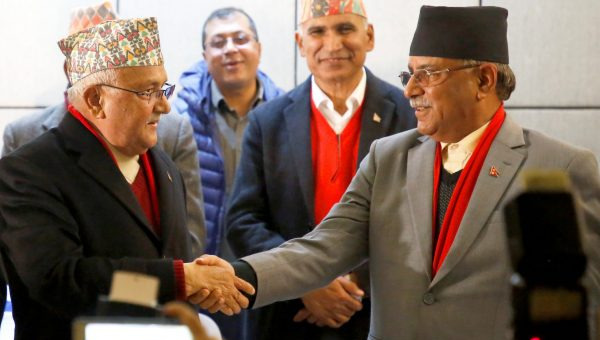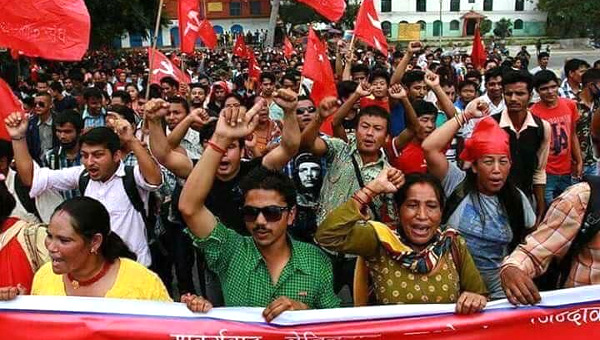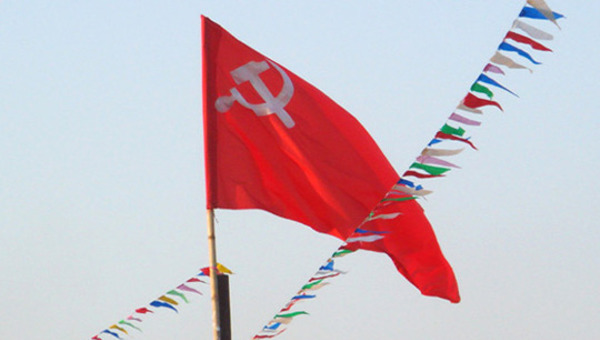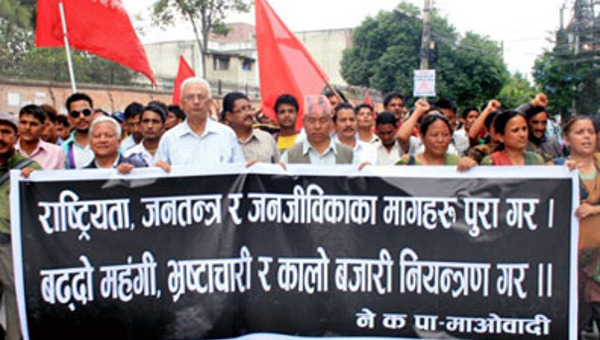Elections in Nepal and Questions for People’s Struggles
After a decade long insurgency with thousands killed, the Nepalese Maoist movement entered a new political phase of contesting the formal political process and promising peace and development. They entered government through a strong election showing for the 2008 Constituent Assembly, charged with writing a new constitution for Nepal after abolition of the monarchy. But political division in the main Maoist movement, alienation
from politics, and strategic impasse characterized much of this period.
As a result of the constitutional impasse, particularly over the proposals for the federal structure and regional autonomy, November elections were called with some 120 parties contesting for 601 seats in a new Assembly. In the national election results, the electoral strength of the Maoist movement received a strong setback, with the ‘centrist’ Nepali Congress Party, one of the oldest parties, gaining considerable ground and coming out the lead party, although the three main communist parties still can claim majority support. Nepal has been one of the few political openings for the Left anywhere in the world, and these results in South Asia merit considerable scrutiny and debate. Here The Bullet presents two contributions to that discussion.
The recent elections in Nepal appear to spell a heavy retreat for the country’s Maoist movement. After initiating a People’s War in 1996 that lasted ten years and saw it in control of the majority of the countryside, the popular Communist Party of Nepal (Maoist) formed a front with mainstream political parties to overthrow the monarchy and institute a democratic republic in the 2006 People’s Movement. Thereafter, the CPN (Maoist) emerged as the largest party in the 2008 Constituent Assembly (CA) elections.
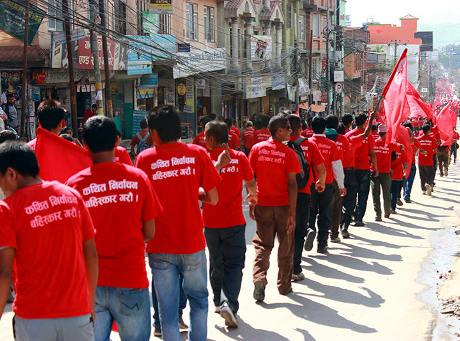
Meanwhile, the Communist Party of Nepal-United Marxist-Leninist (UML), which despite its name does not pretend to have revolutionary or even broadly progressive politics, has come in second place after the Nepali Congress, whose politics is hard to tell apart from that of the UML. Their victory then seems like a gain for the right in Nepal.
Understanding Politics in Nepal
But putting elections at the centre of our analysis can take away from understanding politics in Nepal. Dramatic changes in Nepal’s recent political history have occurred as a result of non-electoral politics that have often been spearheaded by or have involved considerable popular communist agitation. What’s more, Maoists came third in the 1991 elections (with 9 seats) and boycotted elections in 1994 and 1999, but that didn’t stop them from becoming the country’s largest and most influential political force by 2006.
Let us then turn to understanding four questions: First, what led to one Maoist faction engaging in elections and the other deciding to boycott the CA process in its entirety? Second, what were the reasons for the boycott called by the CPN-Maoist? Third, why did UCPN (Maoist) lose the elections? Fourth, was the CPN-Maoist boycott a failure?
1. Why Did the Maoists Split?
In order to overthrow the monarchy and establish a republic, the Maoist leadership, particularly the reformist faction led by Chairman Prachanda and Vice-Chairman Baburam Bhattarai, entered into a compromising peace process with the mainstream political parties (Congress and UML). The Maoists also compromised on their own revolutionary ideals, a betrayal that greatly disappointed core supporters and non-core swing supporters, not to mention the radicals in the Maoist party.
The reformist Maoist leaders pushed to dismantle the system of popular power they had developed in villages across Nepal in the course of the ten-year People’s War. Rather than people having to go to district capitals to settle their disputes in formal courts, an arduous and expensive process, the Maoists had developed people’s courts that would settle disputes quickly and usually fairly. Ordinary people were brought into people’s committees with Party cadre in order to make decisions about village affairs. In many places, semi-feudal landlords were driven out of villages and land was redistributed among the landless. This is not to romanticize what the Maoists achieved, certainly these developments were uneven and not all rosy – yet they were real gains that made Maoists popular among broad masses. These achievements were actively reversed in order to enter into the peace process that led to the CA elections.
Upon forming government, the Maoists found that the institutions of the state were not in their favour, as these institutions are heavily structured by Nepal’s ruling classes and foreign domination. The Maoists resigned in protest in 2009 as they could not exercise civilian control over the chief of the Army, which was backed by the United States and India. The Maoists did not take the reigns of government again until 2011, only to soon dissolve the CA in 2012. Out of five years of the CA, the Maoists governed more-or-less for two years, where the institutions of the bourgeois, neo-colonial state were hostile to them. Clearly, this wasn’t going to help the masses build confidence in the CA or in the Maoists as an electoral party.
To be clear, the first government of the Maoists was widely applauded due to Bhattarai’s finance ministry, which controlled prices of some commodities, in part by extracting greater tax revenue than had ever been extracted before – and in the process, further antagonized the corrupt bureaucracy. Yet, the second government was led by Bhattarai as prime minister, and this time there was no plan to combat inflation, to safeguard Nepal’s economic sovereignty against Indian and Western intervention, or to put a hold on neoliberal capitalism. Instead, Maoist leaders – especially those who had seats in the CA – were seen to have become increasingly corrupt, enriching themselves off of deals with contractors and real estate developers. “They used to be thin during the People’s War,” someone told me back in 2010. “But now in the cities they have become fat.”
Meanwhile, the peace agreement held that the Maoists’ People’s Liberation Army (PLA) would be integrated into the Nepal Army. The goal was to integrate entire units, yet the actual integration took the form of individuals being recruited into the Army. Some former PLA soldiers were given jobs like park rangers, while others were given cash payments to demobilize entirely. The integration turned out to be a sham, and an affront to the dignity and sacrifices of far too many PLA fighters. Over 14,000 people died in the ten-year People’s War, most of them as a result of the violence of the state.
The reversal of popular power and other gains of the revolution, the increasing corruption in the ranks of the party, and the undignified assault on and dissolution of the PLA were not taken well by the rank-and-file of the party or by the more radical leadership, headed by Vice-Chairman Kiran – who had been protesting the turn of events in the party for many years. In a bid to maintain party unity, radicals held on until 2012, but increasing differences finally led to a split. The UCPN (Maoist), by now, had decided to continue on to the electoral process in order to achieve a “capitalist revolution.” The CPN-Maoist, however, decided to stick to the line of “new democratic revolution,” building the power of the working-class and the peasantry in a way that would lead to socialism.
2. Why Boycott a New Constituent Assembly?
Nepal’s politics and economy have historically been dominated by external powers, particularly India to its south. Western powers have come to exercise considerable influence in Nepal through foreign aid and NGOs. What international powers want in Nepal is for there to be no radical social and economic transformation. In India, Maoists constitute the severest “internal security threat” to the ruling classes – a communist revolution in Nepal would reverberate not only in India, but across the region and across the world as the first successful socialist revolution since 1979.
Yet, international powers also have no desire to address the factors that led to the insurgency and revolution in the first place – underdevelopment, widespread poverty and inequality, caste and gender discrimination, ethno-national oppression, and so on. What they would like is a pastiche of India, a liberal, parliamentary democratic set up with no real substantive transformation of society. Due to this external influence, Nepal has not been able to engage in autonomous development.
The Nepali Congress and UML are close to India and have no agenda for autonomous development in Nepal, and the reformist factions of the Maoist leadership have become more in tune with neoliberal capitalism – and more in tune with India. (In fact, Bhattarai’s government entered into even more unequal treaties with India, among other things resulting in the further opening up of Nepal’s hydroelectric potential to Indian exploitation.)
In four years of the CA, the constant political posturing and bickering of the parties (with four prime ministers in four years) was stoked by constant meddling by India and other foreign powers, seeking to secure their own interests in Nepal. Rather than the CA as a whole, responsibility for decision-making was delegated to party leaderships who would conduct negotiations to reach a consensus. Most of the articles of the constitution had been agreed upon, with only a few issues outstanding – mainly on how to set up a proposed federal structure, and with what number and kind of new provinces to be created. No consensus was reached before the final deadline as set by the Supreme Court.
The four “big” parties – UCPN (Maoist), Congress, UML and the United Democratic Madheshi Forum – decided to turn over the government to the Chief Justice (against the terms of the Interim Constitution of 2007) to supervise a new round of CA elections.
For the CPN-Maoist, this was an absurd proposition. The Chief Justice – notoriously anti-Maoist – was undemocratically and unconstitutionally appointed prime minister by fiat (remember, the CA had been dissolved). In fact, the appointment of the Chief Justice was heavily favoured by the international powers as well. Moreover, what would a new CA do to resolve the political differences that led to the failure of the last one? Instead, the CPN-Maoist, leading an alliance of 33 parties also represented in the first CA, called for a round-table conference of all political parties to hammer out the outstanding issues and then take a constitution to the masses for ratification.
Rejecting this, the four mainstream parties and the international powers pushed ahead with the second CA elections. As a result, the CPN-Maoist and the 33-party alliance called for a boycott. Fifty-two election observation NGOs became operational, the seven largest of which are funded by Western donors – for example, the National Election Observation Committee (NEOC) is funded by the UK Department for International Development (DFID) and the European Union – the very donors pushing hard for elections. In violation of the peace agreement of 2006, the Nepal Army – backed and trained by the U.S. and India – took to the streets to guarantee that the elections took place. The mainstream parties and international powers cannot abide a power vacuum in Nepal that may open up opportunities for popular revolutionary mobilization.
3. Electoral Failure of UCPN (Maoist)
The Maoists’ personal sacrifice and simple lifestyles, which were then translated into systems of popular power, brought hope for a new form of political engagement throughout the country. In parliament, the reformist factions lost their discipline and degenerated into a corrupt, purely electoral formation. If there was no alternative to be expected from the electoral activities of the Maoists, then the non-core voters who supported them in 2008 had no reason to support them again. Congress and UML could play the game of mainstream politics far better – and that might explain why these elections have seen a reversion to the mainstream parties, especially in urban centres.
Ironically, the reversal of land reforms and institutions of popular power in the countryside might have helped Congress and UML win in the rural centres as well. Relatively powerful landowners can influence and facilitate access to governmental and judicial services. This political monopoly over state patronage is what got Congress and UML elected in previous elections. Even if feudalism as it once existed was greatly weakened after the People’s War, reconfigurations of power relations were probably much better exploited by the mainstream parties, with their long experience in the matters, than the UCPN (Maoist).
Crucially, at least part of the collapse of the electoral UCPN (Maoist) has to be explained by the CPN-Maoist call for boycott. The core electoral base of the Maoists appears to have decided not to vote at all, or were prevented from voting – leading to the UCPN (Maoist)’s dismal showing. Thawang, a village in district Rolpa that has been the epicentre of peasant revolt and Maoist support, recorded zero votes.
In sum, the electoral failure of the reformist, electoral UCPN (Maoist) has to be attributed to its reneging on revolutionary politics, reversing the political and economic gains of the revolutionary process, and its increasing greed. Indeed, in general, the Maoists achieved great victories when they produced new rules themselves based on popular power. They lost when they submitted themselves to the rules set up by the ruling classes and imperialists. This understanding is what led the revolutionary CPN-Maoist to boycott the elections.
4. Failure of CPN-Maoist Boycott?
The boycott led by the revolutionary CPN-Maoist was widely declared a failure by mainstream media because there was a “record” 70 per cent voter turnout. But in number terms, there were well over one million less people voting in this election than the last one. Five million less people even registered to vote in this election. Part of this lower registration was apparently due to tighter control over voter registration by electoral bodies, but at least part of the lower registration can be explained by the political skepticism that runs deep in the Nepalese population. I wouldn’t be surprised if many people who did vote in this election have very little faith in it actually achieving much.
In these senses, the CPN-Maoist led boycott did in fact tap into a great vein of disappointment among the population, and especially the electoral base of the Maoists. This is a slap in the face of the UCPN (Maoist) that vindicates the CPN-Maoist line of boycott.
Moreover, the fact that one of the largest political forces in the country, the CPN-Maoist, has stayed out of the CA process (and seems intent on staying out of it) calls into question the very credibility of the CA. After all, the goal of a CA is to form a constitution, and that requires the participation of a wide range of political opinions in the country – not least one of the largest and influential ones.
The idea that the CPN-Maoist, by rejecting the elections and promoting a boycott, were engaged in anti-democratic behaviour is absurd. The entire political process in Nepal has been characterized by politicking that violates previously agreed-to rules and liberal democratic norms – such as the separation of powers between the judiciary and executive, the primacy of parliament, the demobilization of the Nepal Army, the immense foreign interference, and so on.
What the boycott failed to do was to stop the elections altogether. This was certainly a goal of the revolutionary Maoists and they did not achieve it, but it was also an important method for them to assess the spread of support and influence they have in the country. In February 2013, a senior revolutionary Maoist leader told me that if they stopped the elections, we could expect a quicker path to revolution, and if they did not, we could expect a more protracted approach. In other words, the boycott is a tactic in a developing and shifting strategy.
Indeed, when the united Maoist party entered into the peace process in 2006 and elections in 2008, these were also seen as tactical moves – not as a strategy for achieving socialism. Despite their overwhelming control of the countryside, Maoists could not enter the cities due to their being heavily guarded by the Royal Nepal Army – funded and backed by the U.S. and India. Their idea was thus to use a peace deal to enter into the cities and rebuild organizations there, for an eventual urban insurrection to overthrow the government. The insurrection nearly materialized in 2010, with Kathmandu shut down by a general strike organized by the Maoists. Yet, the reformists in the leadership decided to call the general strike off to return to electoral politics.
The electoral loss of the UCPN (Maoist) will likely lead many rank-and-file cadre to reconsider their engagement with the reformist leadership and question whether or not the electoral path is the best means of achieving socialism. They may well swell the ranks of the revolutionary CPN-Maoist – very important as the party seeks to restructure, restrategize, and regain the confidence of the masses after the betrayals of the reformist leadership of the UCPN (Maoist). Meanwhile, that UCPN (Maoist) leadership has been forced to understand that it cannot play by the rules of the ruling classes and the imperialists. It remains to be seen whether they can throw off the ideological cobwebs induced by mysticism of class collaboration and return to the revolutionary road of class struggle. •
This article first appeared at with BASICS Community News Service. Noaman was in Nepal in December 2010 and in January/February 2013.
Nepal Elections: Defeat for Maoists,
Victory for United Left
Farooq Tariq
I was present as an International Observer to the November 19 general elections in Nepal, invited by the National Election Observation Committee (NEOC). Polling was unexpectedly peaceful. Interestingly enough only 226 out of the 601 Constituent Assembly seats are directly elected. That is, the majority of seats are elected through a proportional voting system.

More than 70 per cent of Nepal’s eligible voters participated in the November 19 vote despite an election boycott and transportation strike by a coalition of 33 parties, led by the CPN-Maoist. It is clear that the boycott strategy failed.
Just eight days after the election – when I am writing these lines – we can begin to view the shape of the new assembly. What is shocking is that right-wing forces have been able to advance despite the fact that three main communist parties CPN (UML), UCPN (Maoist) and CPN-Maoist still remain a major force in Nepal and enjoy the sympathy of the majority.
Background to the Elections
The Maoists fought an insurgency against government troops from 1996 to 2006, joined a peace process and participated in elections in 2008 that they dominated. Many of their fighters joined the national army. But while in power they were unable to offer a compelling alternative. Thus poverty was not reduced and there was no major reform agenda during the power period of the Maoists and UML. This gave an opening for the decaying right-wing Nepali Congress to re-emerge.
As a result, the neoliberal agenda and privatization was maintained. They accepted and cooperated with the Indian ruling classes and did not challenge in an effective manner the hegemony of Indian ruling elite, instead tried their best to win them to their side.
The CPN-Maoists decided to boycott the election because it was being held under an unconstitutional head of the state, the chief justice of Supreme Court, while the United Communist Party of Nepal (Maoist), did contest the election, but secured only 26 directly elected seats. I discovered the CPN-Maoist was called by activists as “dashiest,” and the UCPN (Maoist) as “cashist,” that is, it is believed to be a party with a lot of cash.
The Election Result
The Nepal Congress, the country’s oldest political party and one that favors close ties with India, won 105 of the 240 directly elected seats. The Communist Party of Nepal (Unified Marxist-Leninist) came in second with 91 seats.
Three hundred and thirty-five of the 601 Constituent Assembly seats will be determined by proportional votes. A total of 10,709 candidates from 122 political parties are contesting for those seats. That is, all the votes from the 240 constituencies are accumulated and seats allocated in proportion to the votes secured by the respective political party. The total number of valid votes is divided by 335 to set a threshold for allocating party seats. According to the Election Commission, a party must secure around 25,000 votes to get one seat under the PR system.
By 25th November, the UML had bagged 608,484 of the 2.21 million votes, according to the official website of the Election Commission (EC). Their share of the PR votes as of that evening was 27.48 per cent. The Nepali Congress trailed closely behind the UML with 581,186 votes (26.25 per cent) and the UCPN (Maoist) had 367,132 (16.58 per cent). Rastriya Prajatantra Party Nepal (RPPN) came in fourth with 175,277 votes (7.91 per cent), while the Rastriya Prajatantra Party secured 66,026 (2.98 per cent) of the votes.
One new party Rastriya Prajatantra Party Nepal (RPPN) is calling for restoration of royalty and has taken a significant portion of right-wing vote away from the Nepali Congress. Of the 10 constituencies in Kathmandu district, the RPPN was leading in six with 106,830 votes. The Nepal Congress followed the RPPN in the capital with 104,779 votes, while the UML had bagged 89,028 and the Maoists grabbed 58,220 votes.
Just a day after the elections the Maoist leader Pushpa Kamal Dahal known as Prachanda declared the elections as a “conspiracy” against them and announced boycott of the polling count. He only went to press after it was clear the Maoists are losing badly in the elections. They were the single largest group in 2008 parliament and failed to retain their support among the extremely poor masses of Nepal.
The 2008 parliament was elected for a two-year term in order to draft the constitution after the country was declared the Peoples Republic of Nepal. Despite all efforts of the three main parties, the parliament failed to write the constitution on time. In fact, the parliament extended itself on a yearly basis twice but they were deadlocked over whether to adopt a parliamentary or presidential system of government, and whether ethnicity or geography should be used to divide the country into states.
According to one commentator, Professor Kapil Shershta, who I met in Kathmandu, “the last parliament did everything else apart from the task they were elected for, the writing of the constitution.”
On the other hand, the former attorney general of Nepal, said, “the process of constitution making has gone considerably well during the last five years but a constitution is not just a set of few principles written by an expert, it is a process of constitution-making with people’s aspirations. Political parties have not failed in writing the constitution but have done well in reaching consensus in the most difficult objective conditions.” He was speaking at the pre-poll observation consultation meeting I attended two days before the elections in Kathmandu.
Despite Maoist boycott of poll counting, Nepal’s election commission has ruled out a revote or recount. “We are not in a position to review the vote after all parties were provided chances to review the entire process,” said the chief election commissioner, Neel Kantha Uprety. Lok Raj Baral, executive chairman of the Nepal Center for Contemporary Studies, said the Maoists’ dismal performance shocked everyone. But he predicted that they would participate in the Constituent Assembly’s constitution-writing process.
The 2013 elections have not produced a single political party capable of forming the government on its own. The ideal would have been a loose alliance of the two main communist parties, the UML and the UCPN (Maoist). They have a majority in the parliament if in an alliance. However, the 2013 elections have created new difficulties and complexities for the political parties’ task of writing the constitution. UML leader Madden Nepal projected completing this task within a year and after winning two seats has emerged a powerful respected leader. However, is this possible?
In this election the masses punished those who they felt could not do the job properly. They have shown some expectations for the right-wing forces. However, they have not decisively rejected the communists. The UML is now a poll of attraction for the majority of the Nepali masses.
Yet the UML would have to break their reliance on the Indian ruling class, reject a stagist theory of revolution and above all break with a neoliberal agenda and imperialist forces. They seem to have the confidence of the masses but can they move forward in terms of socialist consciousness.
The Nepal election is an eye opener for all the Left forces. Despite all the ideological weaknesses, the Left remains a mass force that is not seen in any other country of the region. The masses seem to have tried the Maoists and have now shifted to the UML. The Left in Nepal remains a poll of attraction. It is the Left of Nepal that has to move toward more socialism than less socialism. •
Farooq Tariq is General Secretry of Awami Workers Party Pakistan. This article first published on the viewpointonline.net website.


